How to Manage Conflict in Meetings

Introduction
The Importance of Managing Conflict in Meetings
Conflict is a natural part of human interaction, and it can occur in any setting, including meetings. When managed effectively, conflict can lead to constructive discussions, innovative solutions, and better decision-making. However, when left unaddressed or poorly managed, conflict can escalate and negatively impact team dynamics, productivity, and overall meeting outcomes.
Preview of Key Strategies and Insights
In this article, we will explore various aspects of managing conflict in meetings, providing practical tips and best practices to ensure productive and harmonious team interactions:
- Understanding conflict in meetings
- Preparing for conflict management
- Strategies for managing conflict in meetings
- Common mistakes to avoid
- Best practices for managing conflict in meetings
- Case studies of successful conflict management in meetings
By implementing the strategies and insights discussed in this article, you will be better equipped to manage conflict in your meetings, fostering a positive and collaborative environment that encourages open communication and drives success for your team and organization.
Understanding Conflict in Meetings
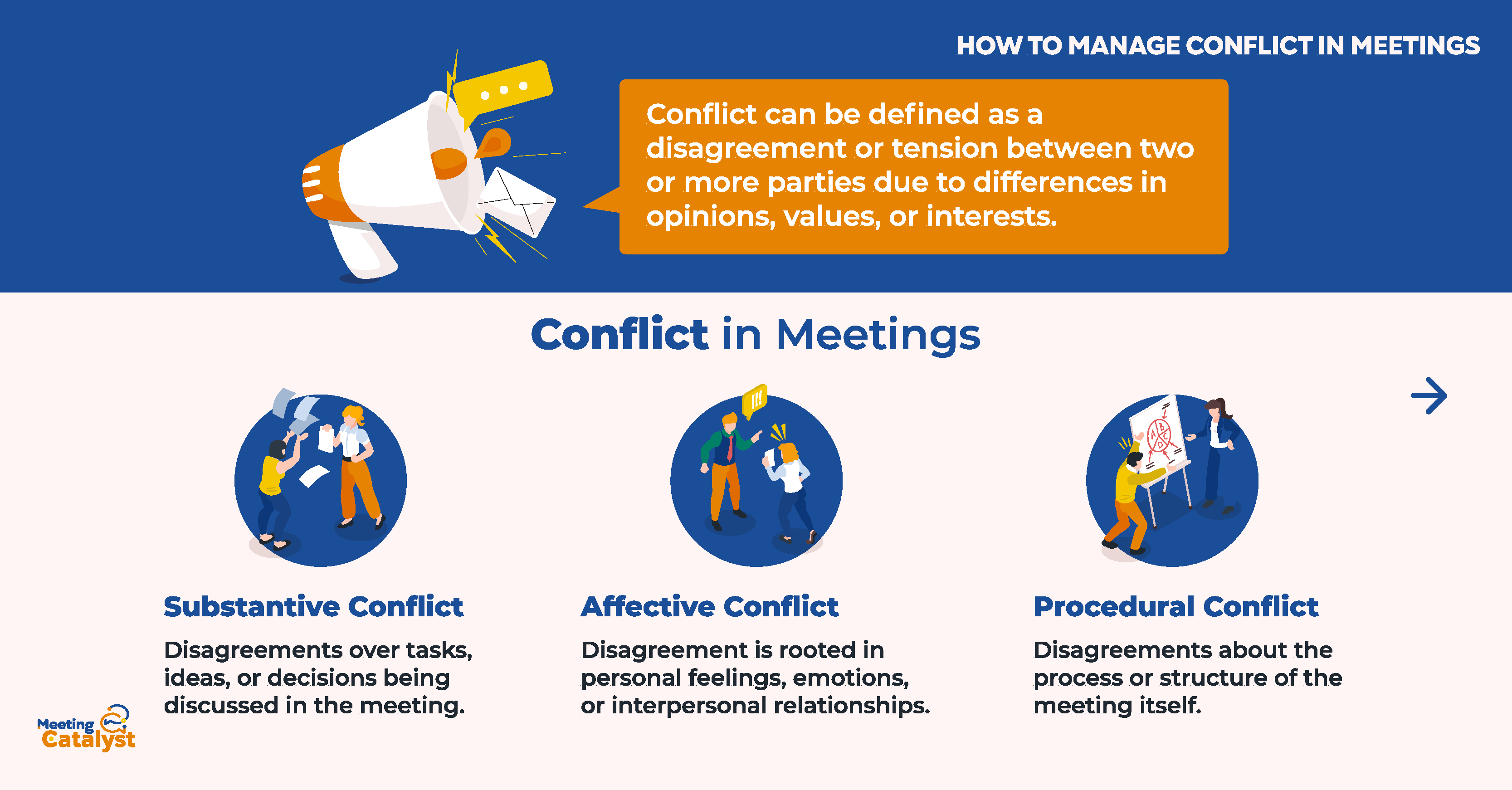
Before delving into the strategies for managing conflict in meetings, it's essential to understand what conflict is, its types, and the causes and consequences of conflict in meetings. By recognizing these aspects, you can better address conflict and leverage it constructively.
Defining Conflict and Its Types
Conflict can be defined as a disagreement or tension between two or more parties due to differences in opinions, values, or interests. In the context of meetings, conflict typically falls into three main categories:
Substantive Conflict: This type of conflict arises from disagreements over tasks, ideas, or decisions being discussed in the meeting. It is often based on differences in perspectives, priorities, or goals.
Affective Conflict: Affective conflict occurs when the disagreement is rooted in personal feelings, emotions, or interpersonal relationships. This type of conflict can lead to negative emotions, such as anger or frustration, and can be particularly damaging to team dynamics.
Procedural Conflict: Procedural conflict arises from disagreements about the process or structure of the meeting itself, such as the agenda, time allocation, or decision-making methods.
Causes and Consequences of Conflict in Meetings
Conflict in meetings can arise from various factors, such as poor communication, differing expectations, power struggles, or external pressures. When not managed effectively, conflict can lead to:
- Decreased productivity and efficiency
- Strained relationships and team dynamics
- Lower morale and job satisfaction
- Reduced creativity and innovation
- Hindered decision-making and problem-solving
On the other hand, when managed constructively, conflict can bring about positive outcomes, such as:
- Enhanced understanding of diverse perspectives
- Improved problem-solving and decision-making
- Strengthened relationships and trust among team members
- Increased creativity and innovation
By understanding the nature of conflict in meetings, you will be better prepared to address it effectively and leverage it to drive positive outcomes for your team and organization.
Preparing for Conflict Management
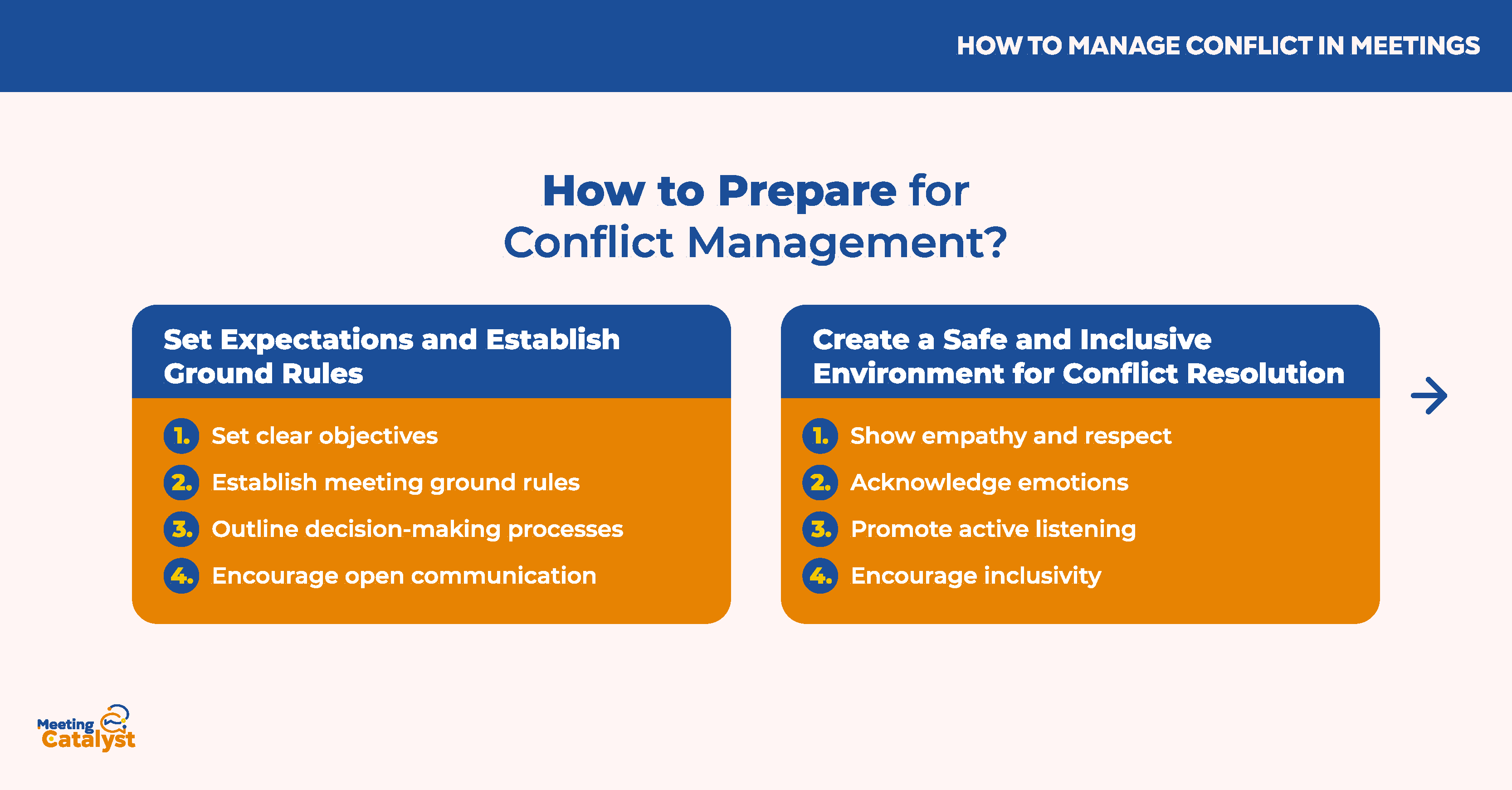
Being proactive and preparing for conflict in meetings is crucial for effective management and resolution. This section will discuss the importance of anticipating conflict, setting expectations, establishing ground rules, and creating a safe and inclusive environment for conflict resolution.
The Importance of Preparing for Conflict
Conflict is an inevitable part of group dynamics, so it's essential to be prepared to address it when it arises. By anticipating and preparing for potential issues, you can minimize the negative impact of conflict on your meeting and foster a more productive and collaborative atmosphere.
Strategies for Setting Expectations and Establishing Ground Rules
To proactively manage conflict in meetings, consider implementing the following strategies:
- Set clear objectives: Clearly define the purpose and goals of the meeting, so all participants understand what is expected of them.
- Establish meeting ground rules: Create a set of agreed-upon guidelines that outline how participants should behave during the meeting. These rules can include respecting others' opinions, allowing everyone an opportunity to speak, and addressing conflicts respectfully.
- Outline decision-making processes: Clearly communicate the decision-making process and any voting or consensus-building methods that will be used to resolve conflicts.
- Encourage open communication: Foster an environment where team members feel comfortable expressing their opinions, concerns, or disagreements without fear of retaliation or judgment.
Creating a Safe and Inclusive Environment for Conflict Resolution
An essential aspect of preparing for conflict management is fostering a safe and inclusive environment that encourages open dialogue and constructive resolution. To achieve this, consider the following tips:
- Show empathy and respect: Demonstrate understanding and consideration for others' perspectives, even if you disagree with them.
- Acknowledge emotions: Recognize and validate the emotions that may be present during conflicts, as they can provide valuable insights into underlying issues.
- Promote active listening: Encourage team members to listen attentively to others and avoid interrupting or dismissing their viewpoints.
- Encourage inclusivity: Ensure that all participants feel valued and included by providing equal opportunities to contribute and acknowledging their input.
By preparing for conflict management in meetings, you will be better equipped to handle disagreements and tensions when they arise, ultimately leading to more productive and harmonious meetings.
Strategies for Managing Conflict in Meetings
Effectively managing conflict in meetings requires a combination of practical techniques and interpersonal skills. This section will provide specific tips and strategies for handling conflict, including active listening, assertiveness, empathy, collaborative problem-solving, and seeking third-party assistance.
Active Listening and Communication Skills
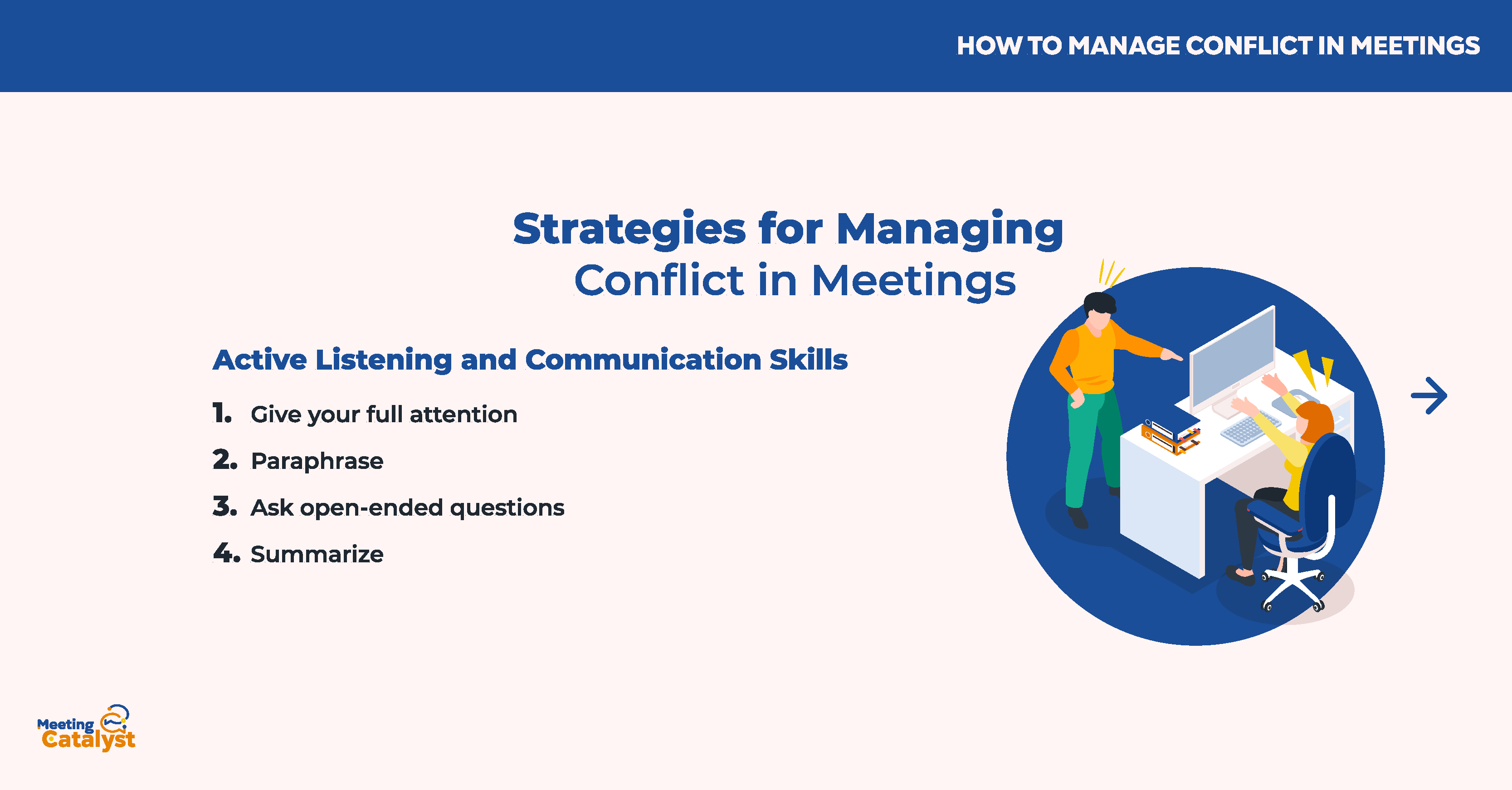
The foundation of successful conflict management is effective communication. To ensure open and constructive dialogue, practice the following active listening techniques:
- Give your full attention: Focus on the speaker, avoid interrupting, and maintain eye contact.
- Paraphrase: Restate what the speaker said in your own words to show understanding and clarify their message.
- Ask open-ended questions: Encourage further discussion and exploration by asking questions that cannot be answered with a simple "yes" or "no."
- Summarize: Briefly recap the key points of the conversation to ensure everyone is on the same page.
Assertiveness and Empathy
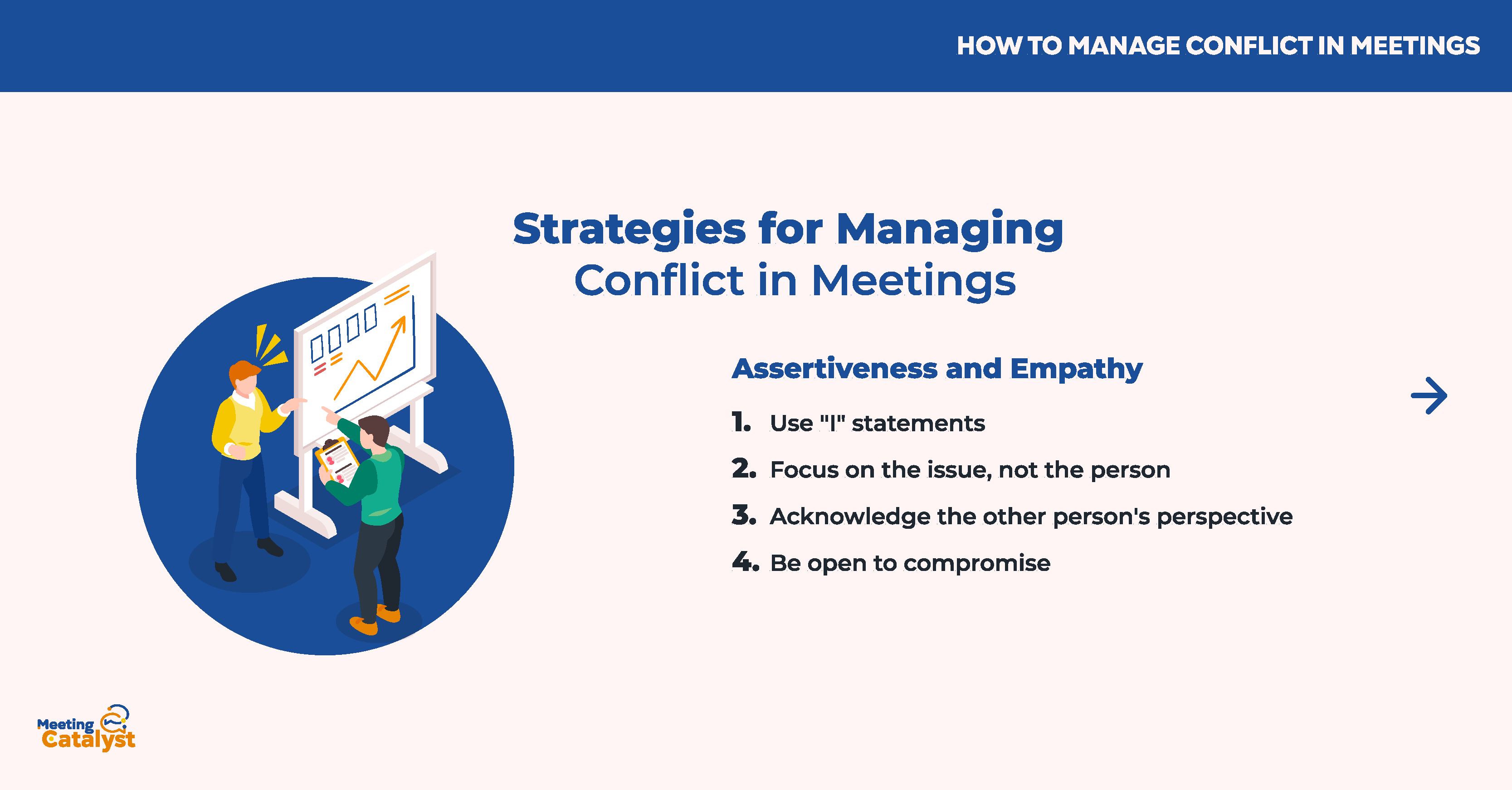
Balancing assertiveness with empathy is crucial for managing conflict in a respectful and productive manner. Implement these strategies to effectively address issues while maintaining positive relationships:
- Use "I" statements: Express your thoughts and feelings by starting sentences with "I" to avoid sounding accusatory or confrontational.
- Focus on the issue, not the person: Separate the problem from the individual to avoid personal attacks or blame.
- Acknowledge the other person's perspective: Show empathy by recognizing and validating the other person's feelings and concerns.
- Be open to compromise: Demonstrate a willingness to find a mutually agreeable solution.
Collaborative Problem-Solving and Negotiation
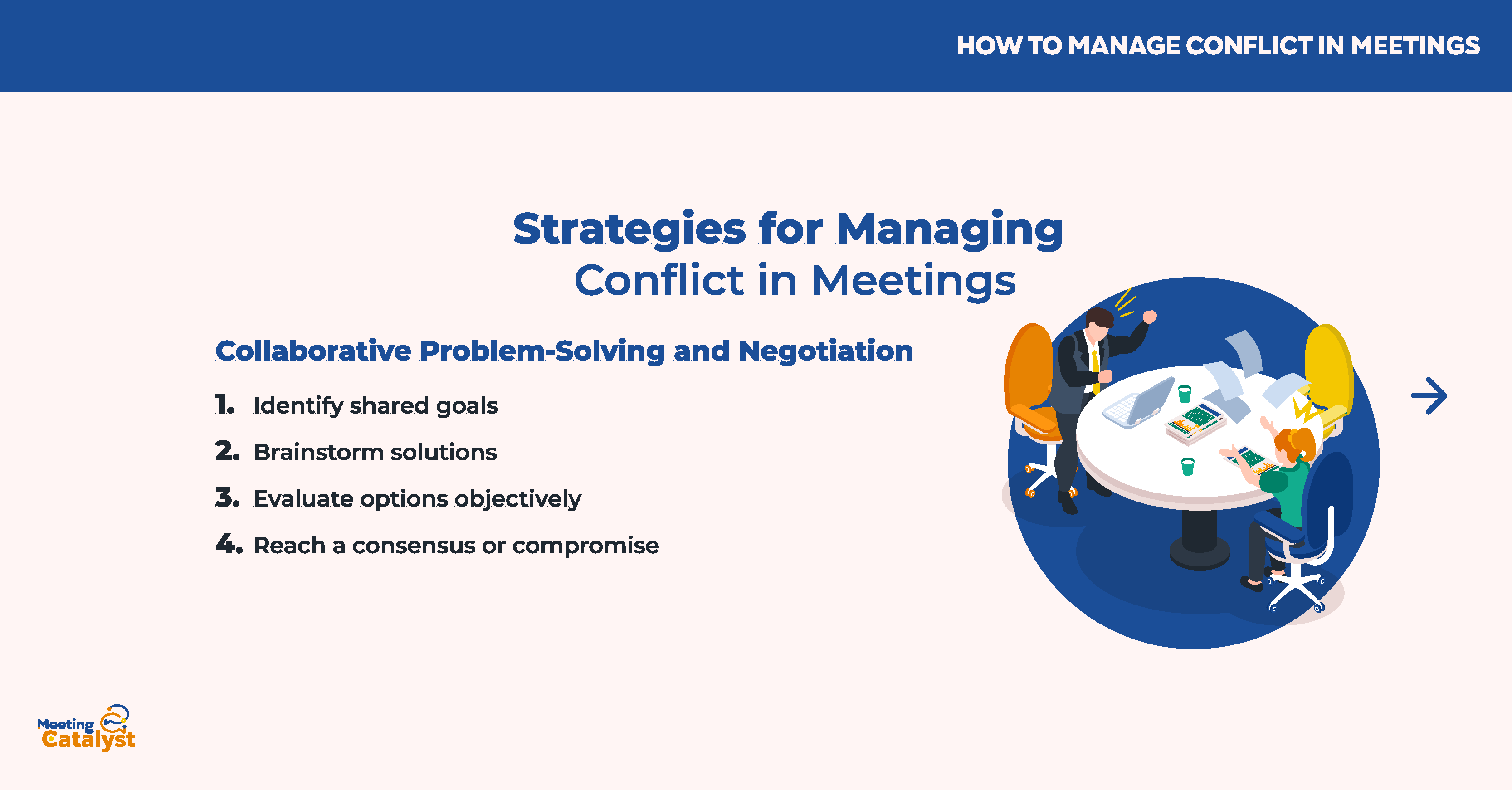
Resolving conflict in meetings often involves finding common ground and working together to develop a solution. Use the following collaborative problem-solving and negotiation techniques:
- Identify shared goals: Focus on common objectives and areas of agreement to foster cooperation.
- Brainstorm solutions: Generate a list of potential solutions without evaluating them at first, then discuss the pros and cons of each option.
- Evaluate options objectively: Assess the feasibility and consequences of each solution, considering the interests of all parties involved.
- Reach a consensus or compromise: Work towards a resolution that addresses the needs and concerns of all participants.
Seeking Third-Party Assistance
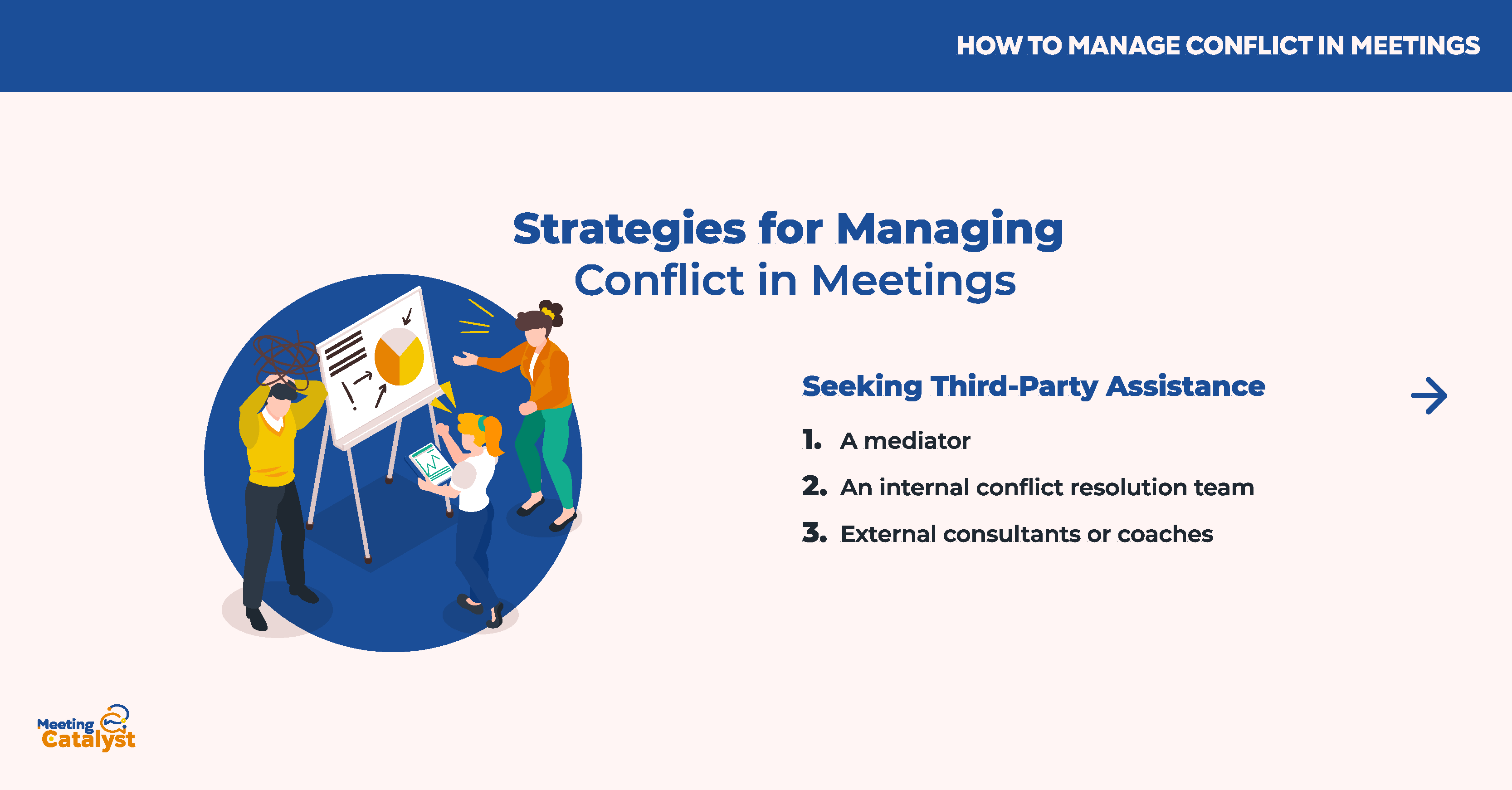
Sometimes, conflicts in meetings can become too complex or emotionally charged to be resolved internally. In such cases, consider seeking help from a neutral third party, such as:
- A mediator: An impartial facilitator who can help guide the conversation and foster understanding between conflicting parties.
- An internal conflict resolution team: Some organizations have designated teams or individuals trained to handle workplace conflicts.
- External consultants or coaches: Professionals with expertise in conflict management can provide guidance, training, and support.
By employing these strategies, you will be better equipped to manage conflict in meetings effectively, leading to more productive and harmonious discussions.
Common Mistakes to Avoid
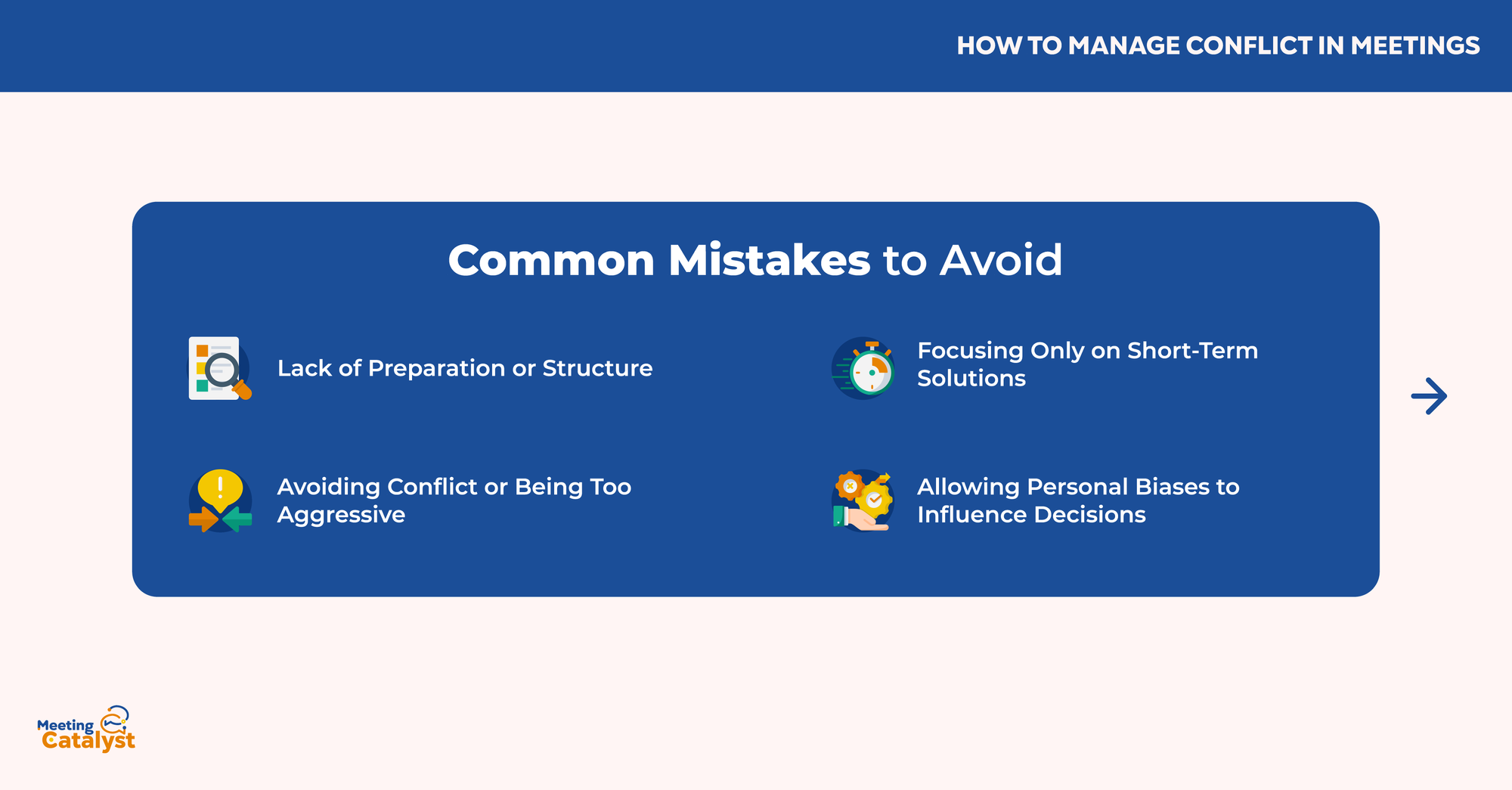
Managing conflict in meetings can be challenging, and it is not uncommon for leaders to make mistakes in the process. Being aware of these potential pitfalls can help you avoid them and foster a more effective approach to conflict resolution. Here are some common mistakes to watch out for:
Lack of Preparation or Structure
Failing to adequately prepare for potential conflict or provide a clear structure for addressing it can exacerbate tensions and hinder resolution. To avoid this mistake:
- Anticipate potential areas of disagreement and develop a plan for addressing them.
- Set clear ground rules for respectful communication and problem-solving.
- Allocate sufficient time for discussing and resolving conflicts during the meeting.
Avoiding Conflict or Being Too Aggressive
Striking the right balance between avoiding conflict and addressing it head-on is crucial. To ensure a healthy approach to conflict management:
- Recognize that conflict is a natural part of group dynamics and can lead to positive outcomes when managed constructively.
- Avoid sweeping issues under the rug, as this can lead to resentment and unproductive behavior.
- At the same time, refrain from being overly aggressive or confrontational, as this can escalate tensions and create additional barriers to resolution.
Focusing Only on Short-Term Solutions
It can be tempting to seek quick fixes for conflicts, but this approach may not address the underlying issues or provide sustainable resolutions. To ensure long-term success in conflict management:
- Focus on identifying the root causes of conflicts, rather than just treating the symptoms.
- Seek solutions that address the needs and concerns of all parties involved.
- Be prepared to invest time and effort in developing and implementing lasting resolutions.
Allowing Personal Biases to Influence Decisions
Personal biases can cloud judgment and compromise the fairness of conflict resolution. To minimize the impact of biases:
- Be aware of your own biases and make a conscious effort to set them aside.
- Encourage diverse perspectives and opinions, and strive for objectivity in decision-making.
- Consider seeking input from neutral third parties to ensure a balanced approach to conflict management.
By avoiding these common mistakes, you can improve your ability to manage conflict in meetings effectively and foster a more productive and harmonious environment for your team.
Best Practices for Managing Conflict in Meetings
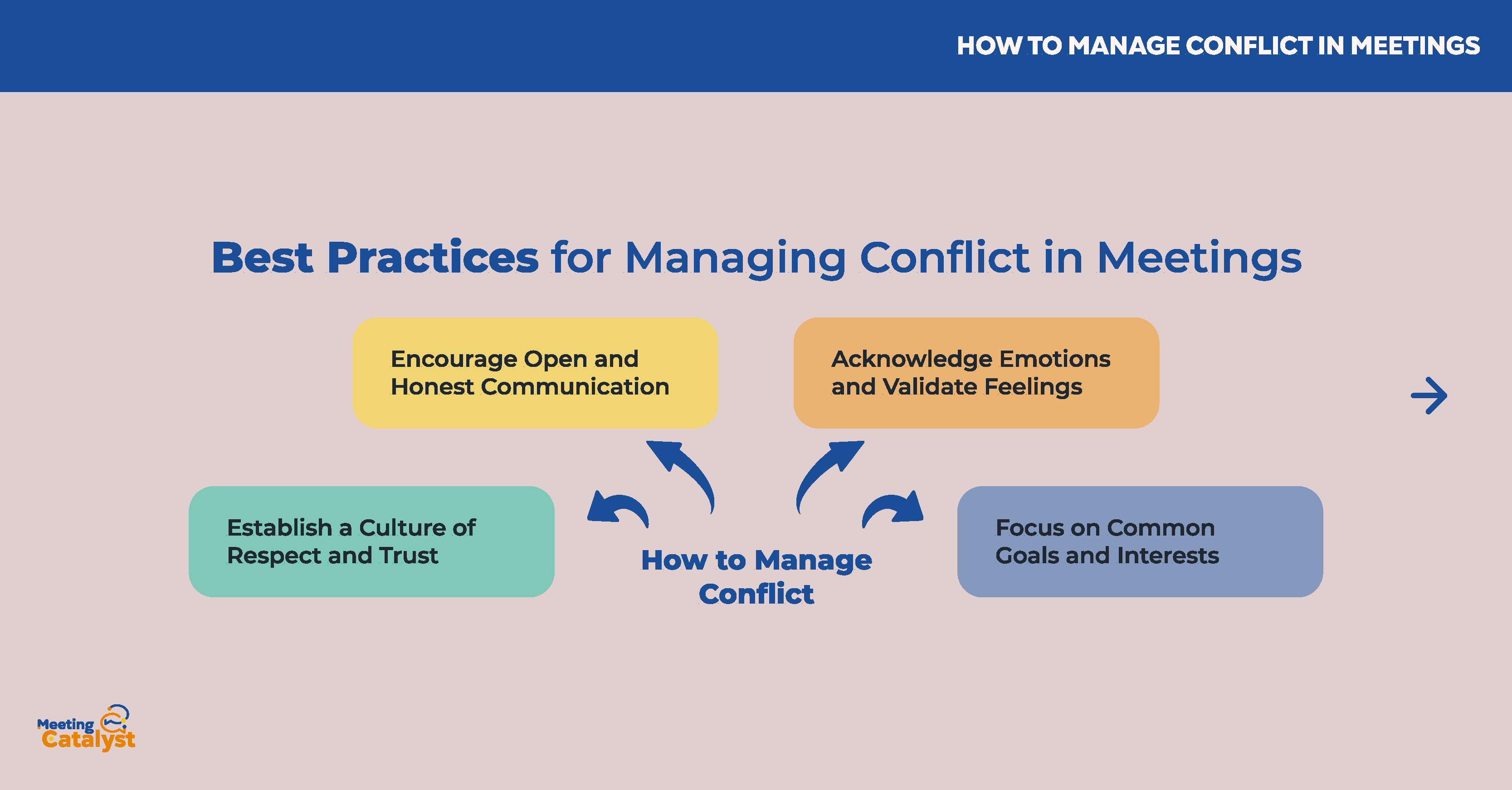
Conflict management is a critical skill for business and team leaders to master. By implementing best practices, you can create a more productive and harmonious environment for your team. Here are some key dos and don'ts for effective conflict management in meetings:
Establish a Culture of Respect and Trust
A respectful and trusting atmosphere can lay the groundwork for constructive conflict resolution. To cultivate this culture:
- Set clear expectations for respectful behavior and communication.
- Demonstrate trust in your team members by giving them autonomy and acknowledging their expertise.
- Encourage open dialogue and active listening, so everyone feels heard and valued.
Encourage Open and Honest Communication
Open and honest communication is essential for addressing and resolving conflicts. To foster transparent dialogue:
- Provide a safe space for team members to express their thoughts and concerns without fear of retaliation.
- Encourage team members to share their perspectives and listen to one another with empathy and understanding.
- Use "I" statements and non-confrontational language to express concerns and avoid triggering defensiveness.
Acknowledge Emotions and Validate Feelings
Emotions play a significant role in conflicts, and acknowledging them can help create a more empathetic environment. To validate feelings:
- Recognize and accept that emotions are a natural part of conflict.
- Give team members the opportunity to express their feelings and emotions without judgment.
- Validate emotions by acknowledging their importance and impact on the situation.
Focus on Common Goals and Interests
Identifying shared goals and interests can help align team members and facilitate conflict resolution. To focus on commonalities:
- Redirect discussions from personal disagreements to shared objectives and desired outcomes.
- Encourage collaboration by identifying areas of agreement and building on them.
- Frame conflict resolution as a joint problem-solving effort, rather than a competition between opposing parties.
By incorporating these best practices into your approach to conflict management, you can create a more effective and harmonious environment for your team to navigate and resolve conflicts in meetings successfully.
Conclusion
Conflict is an inevitable part of any meeting, but when managed effectively, it can lead to better decision-making, stronger relationships, and improved outcomes for your organization. Throughout this article, we've discussed:
- The importance of understanding the types and causes of conflict in meetings.
- The value of preparing for conflict management and establishing ground rules.
- Practical strategies for managing conflict, such as active listening, empathy, and collaborative problem-solving.
- Common mistakes to avoid, like lack of preparation or being too aggressive.
- Best practices for managing conflict, including fostering a culture of trust and open communication.
- Real-life examples of successful conflict management in meetings.
By implementing the strategies and best practices discussed in this article, you can transform your meetings into more productive and harmonious spaces, where conflict is addressed constructively and leads to positive outcomes. As a business or team leader, it's crucial to embrace these techniques and foster an environment that encourages open dialogue, mutual respect, and effective conflict resolution.
It's time to take action – start implementing these conflict management strategies in your own meetings and witness the transformative impact on your team dynamics and overall organizational success.